Herbs are useful in everybody’s kitchen as they provide so much flavour to foods. Most herbs do not take a lot of room and therefore can be grown in small spaces. They also do not take much looking after, as it seems that herbs thrive on neglect.
As most of our herbs come from the Mediterranean hillside then they can grow on the harshest conditions. They prefer to be grown in a mix of multipurpose compost with sharp sand, in a ratio of 2 parts multipurpose to 1 part sand. You can add grit to make it more free flowing and not too water retentive.
Herbs hate heavy clay soil and if you have this soil type, it is better to grow herbs in containers, where the compost that is chosen can be controlled.
YOU CAN GROW HERBS IN SMALL SPACES
You can have a container herb garden in small spaces, with smaller herbs in the front, and taller herbs at the back (like Rosemary and Sage). It would also make access to the herbs easier. Normally it is recommended to have herbs near the front door to make access to them easier for the discerning cook. All herbs like a sunny location, so do not grow them in the shade.
If you have no room outside, you can grow them on a window sill in the kitchen. The herbs you can grow this way include, basil, chervil, chives, parsley, and thyme, as they do not occupy a large area.
What follows is the herbs which can be grown in containers:
BASIL
This flavoursome herb often goes with tomatoes, where it gives pasta dishes an extra zing. Basil can often be bought already potted in supermarkets, but they tend to be packed in too tightly, so the plant tends to suffer. You can split it into halves or quarters and then re-pot each division into new compost, but this is a bit hit-and-miss. It may take and grow well or it will simply die.
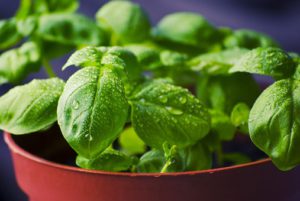
If you want to succeed with basil you need to grow from seed. They will last longer and have an extra benefit of you can choose the variety that tickles your fancy, as there are hundreds. The most popular variety is Basilico Genovese, which has a strong scent and flavour.
To grow from seed you need to plant shallowly and thinly from March to May in a seed tray. Grow near a sunny windowsill as they like heat.
Once two weeks have passed the seed will have germinated. You will then need to transplant them to 8cm pots and then grow on until a sufficient root structure is generated. When this happens you can then repot on to a larger pot with a diameter of 15cm in diameter. Pinch out the tops when they reach 20cm in height, in order for the plant to bush out. The pot can be moved outside after hardening off when all frosts have passed.
BAY TREE
Bay leaf tree (laurels) in the garden can grow up to 12m in height and in width. You think that this is far too big to be able to fit in a container, but no, it is possible.
Your starting point tends to be a small specimen bought from the garden centre. Do not be tempted to buy larger, more costly specimens, as they may fail to root.
When you get the plant home repot it to the next available pot size up, using multipurpose compost, with good drainage. It will be a good idea to mix slow release fertilizer with the multipurpose compost when you are re-potting the bay tree.
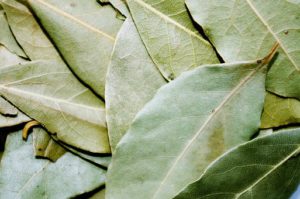
Once established do not be too keen to repot it on, as the tree does not mind being root bound. Prune the tree to keep it in shape. You can practice topiary on it to get the desired shape, being spherical, pyramid or conical. You can bring the artist out within you.
It does not require such a large container, a 60cm pot will do for most trees, which is quite unusual for most tree specimens in containers.
Bay leaves are shallow rooted and so under planting is not recommended. Bay trees Are not totally hardy as severe hard frosts can kill them, so in severe winters it is recommended that the tree is wrapped in horticultural fleece or bubble wrap.
BORAGE
Borage cannot be stored, so you need to use it when fresh. There is a mild cucumber like flavour of the leaves and flowers and goes well as a salad garnish. It also goes well with gin based cocktail and with Pimms.
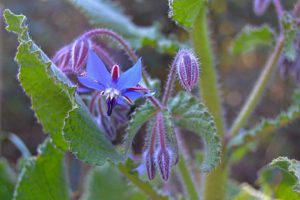
It is a tall perennial growing up to 75cm in height, but it can be straggly and so needs careful attention. Unusually for a herb, it appreciates a richer compost, so use multipurpose and feed at 2 weekly intervals with liquid fertilizer. It is rare but it can be grown from seed.
CHERVIL
This versatile herb goes well with fish and meat dishes. The flavour is described as a mix of aniseed and caraway.

Unusually for a herb, it can be harvested in winter, and will actually grow in partial shade, if a sheltered spot can be found. Alternatively, it can be grown on the windowsill using a 15cm pot.
Can be sown directly in March until late summer, over two to threes week time period for a continual supply. It is quick growing and can be harvested in 6-8 weeks. Young leaves are often preferred, especially before it flowers.
CHIVES
These are one herb that appreciates growing in containers. There are two types; ordinary chives that have an onion-like flavour and Chinese Chives with a more garlic-like flavour. You can tell the difference as the Chinese variety has broader leaves.
The flower heads are edible, once that emerge from the grass-like leaves. The problem is once chives flower they stop producing leaves, so if you want leaves you need to remove all flowering spikes, once they start to appear.
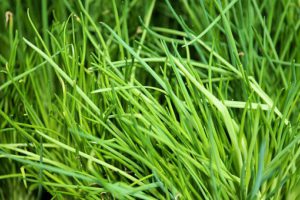
They can be either bought from garden centres or you can start from seed. From March sow seeds in pots or seed trays in a warm place (around 20 C) and they will germinate within 3 weeks, so be patient. Once emerged they can be transplanted t0 15cm diameter pots, for the outside or your kitchen windowsill.
Snip leaves at soil level when required using a pair of scissors, do not be too brutal. It needs to be fed once a month with a general fertilizer and keep wet at all times, it does not like dry roots.
They are perennial and so can be used next year, as in spring that leaves once again emerges chive clumps can be divided and re-potted in spring, so getting two or more new plants for free. Chives do not like severe frost and so some shelter is required in winter.
CORIANDER
The one herb I would not grow as I am not fond of its flavour, but many are.
Indian cooking has popularized it, where it is extensively used with curries. It is a dual-purpose herb as its seeds can also be used in cooking. Before buying any seeds make sure that the variety has not been bred for its leaves or for its seeds. Some varieties are produced for the leaves, some for theirs seeds, other for both purposes.
Cut and come again varieties exist, which are good for three cuttings, making them easy for home growing.
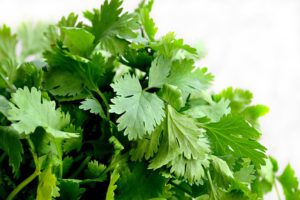
Coriander needs a deep container as they produce a long tap root, which makes transplanting difficult. Coriander needs to be growing in containers in-situ.
Growing coriander from seeds requires a sunny hot place in the container garden. As the plants are prone to bolting you can grow in partial shade, making sure all flower spikes are removed. If the leaves start to yellow or the plant is struggling, feed with a liquid general fertilizer. Can be sown in three weekly intervals for a continuous supply for summer.
DILL
One of the most decorative herbs with fern- like leaves, and a delicate aniseed flavour. A large pot of 30cm in diameter is required, as the herb can top 90cm in height.
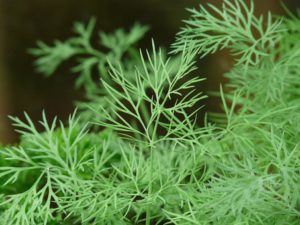
Sow the seeds in 8cm pots in early spring, then transplant to it final pot when the seedling is 15cm in height. They appreciate some protection if the weather suddenly turns cold. Successional sowing at monthly intervals, if you want a continual supply. Dill needs teds to be staked well in order to avoid the plant from flopping over. They prefer full sun but can tolerate some shade.
LEMON GRASS
A much favoured herb in Southern Asian cuisine like Thai and Vietnamese curries and fish dishes. You can grow your own but it is not easy to do. You need to start early, February is the best time. The seed likes a high temperature around 20-25 C. You need to use a seed tray with a propagator lid on it, as the seeds need high humidity in order to germinate. They germinate within 3 weeks, so once again you need to be patient.

When seedlings are large enough to handle, they can be transplanted to an 8cm pot. It needs to be slowly hardened off, before being planted in its final position. It prefers growing in a greenhouse, where the climate can be controlled.
A large pot of at least 30cm in diameter is required, and as it is a perennial then it can be used in the next growing season. If you want to do this, you need to bring the plant inside, as it cannot tolerate any cold temperatures.
MARJORAM AND OREGANO
The difference between the two is so mind-boggling, and you need a degree to understand what is what. All marjoram varieties are oreganos, but not all oreganos are marjorams. Marjorams that are sold in the UK tend to be more tender and are treated as annuals, whilst those described as oregano have a stronger flavour. Oreganos are all perennial in nature.
Oregano is easiest to grow from shop bought plants. A compact variety is best for pots. This is one herb that appreciates being neglected. Fed sparingly, if the plant looks distressed but do not over water as it will kill the plant.
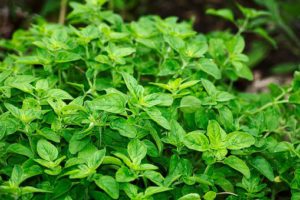
Oregano leaves are best harvested before the plant flowers, as afterwards, it tends to go bitter. After 3 years the plant will look terrible and will become woody in nature, so fresh stock is needed. It needs some protection in winter, as it is not totally hardy.
Marjorams are better treated as annuals grown from seed. They can also be grown as a windowsill specimen.
Seeds can be planted in late winter or early spring in a small pot, covered with Clingfilm to help hold the moisture in, on a sunny window sill. Once again slow germination is expected, as it could take up to 3 weeks before the seedling emerges. Transplant to an 8cm pot of multipurpose compost when large enough, and then to a 30cm pot filled with the mixture recommended in the introduction of this post. Marjoram is best used fresh, whilst oregano is best used dried.
MINT
Mint is one of the few herbs that should always be grown in a container, because otherwise, it will spread like a weed in the garden, smothering other plants in its quest to take over. There are hundreds of varieties of mint from apple mint, chocolate mint, liquorice mint, orange mint, peppermint, pineapple mint, spearmint, etc.
The difference in flavour is very noticeable and it is fun trying to guess what each variety is.
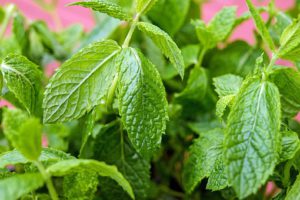
You can grow from seed but the usual practice is to buy pot specimens from garden centres or online.
You can pick the leaves as you need them, whilst pinching the tops off will encourage the mint to bush out. They do not require much looking after but can be fed with general purpose liquid fertilizer when required, especially if the plant does not look well. Mint roots grow super quickly and will fill its container in one growing season. It is recommended that in early spring, the herb is removed from its pot and then divided into two or more clumps, which are then re-potted in the own housing with fresh compost.
PARSLEY
There are two types of parsley; a flat leaf and a curly leaf. Mostly parsley is eaten as a garnish but it can be used to flavour food. Parsley has a flavour that is similar to celery (not surprising as they belong to the same family). Flat leaves are more flavoursome, whilst curly leaves look prettier.
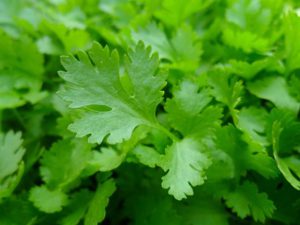
Parsley quite happily will grow in pots and will thrive in a window sill location, as well as outside. Warning, parsley is so slow to germinate, it can take up to a month for the seedlings to show their heads. It is best to start them indoor in seed trays, before moving them onto 8cm pots. They can then be moved onto larger containers in their final position. Do not overwater as the seed will rot.
ROSEMARY
The aroma of these plants are mesmerizing and they do well in a container. It is more of a shrub than a herb. It is best bought as a shop bought specimen rather than starting from seed. This is one plant that does not like being pot bound, so you need to check the roots in order to see if it is becoming root bound, and of the need to be moved to next available pot size up.
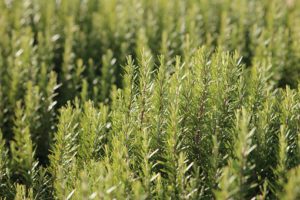
It prefers alkaline soils, so adding a small amount of lime in winter will help it in the forthcoming season. It can be untidy plant with sprig spraying everywhere, but this can be snipped to make it look tidier.
For pots use the upright varieties and not the trailing ones, but the varieties are quite extensive. After a few years as common with these evergreen herbs, it will become sparse and woody. You can take cuttings from the end of a young shoot. Place this in an 8cm pot full of multipurpose compost, and then cover with a plastic bag to keep in the moisture. Keep it in a warm place, out of direct sunlight, and within six to eight weeks you have a new plant.
SAGE
A medicinal herb part of the Saliva family but be warned it has a strong flavour, which can be overpowering, so use sparingly.
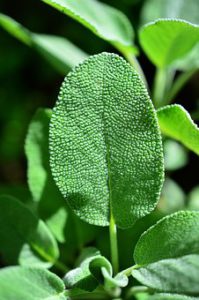
It does well growing in pots both outside and on the window sill. Can be started from seed which takes far too long, or you can buy it from garden centres. Sage does not like wet roots, so it is better to keep the compost on the dry side.
After a few years, it will look quite sparse, with the woody stems becoming easy to break. Staking will protect the plants from damage, especially if it is supported in the right areas.
After a few years, it will need to be replaced anyway, by using the same technique as recommended for rosemary.
Sage does not require feeding and often does better if it is neglected. There are numerous varieties from purple leaves and variegated leaf types. They have even come up with varieties that smell like blackcurrant and pineapple, although do not taste like them.
Common Sage is very hardy, but newer varieties are not so much so. They need to be protected in winter from frosts.
TARRAGON
There are two types; French, which have a finer flavour, or the Russian whose flavour is not as noticeable.
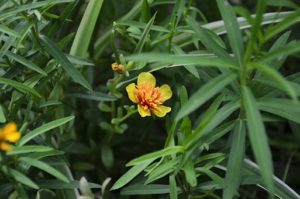
It is best started from shop bought plants rather than seeds, as French varieties will revert back to Russian. It is vigorous plant, growing up to 1.2m in height, but can be grown in large pots, as long as you replace the plant after 3 years. At this time it will look terrible and be root bound. Like Rosemary and Sage, it is easy to grow new plants from cuttings.
THYME
This versatile herb can be used in everything from stuffing, soups, omelettes, etc.
It is actually a mint, believe it or not, but does not taste like mint. Thyme will do well in pots both outdoor and on the windowsill. This perennial will not grow in winter but enters a dormancy stage.

You can start from seed but the usual practice is to buy a shop bought plants. Numerous varieties exist, some have variegated leaves.
The plant would appreciate being fed once a month with general purpose liquid fertilizer during the growing season. In winter do not feed at all.
After three years you can divide the plant into 2 or 4 divisions and then repot, thus obtaining free new plants.
CONCLUSIONS
In this article, the selection of herbs that can be grown in pots has been discussed, along with their ideal growing conditions. As you can see a number of varieties exist, which can satisfy any chef amongst us.
If you have any comments or questions, please feel free to leave them in the comment box below.
Get cooking with herbs.


I absolutely love using fresh herbs in my cooking efforts as opposed to those horrible dried options most supermarkets throw at you these days!
I haven’t really had that much luck growing herbs before but after reading your article I realise that it’s probably down to the wrong soil type and weather (I do live in Wales, after all!).
If I choose to grow them inside on a window sill, is there any heating or temperature requirements I should follow?
Hi Chris
Thank you for the kind remarks. As said in the article most herbs do not like sitting in wet conditions, as this is far from the conditions they are used to growing in. Once the seeds have germinated they do not require any additional heat; just sun, some water, and an occasional feed. Do this, and you will succeed with herbs.
Thanks
Antonio
Hi Antonio,
Lovely blog, lots of information about herbs and how to grow them in containers, an absolute must read for anyone wishing to learn about growing herbs for the kitchen and needing one help and advice. Its so easy to have plants in pots, especially if limited on space. Herbs are ideal plants for growing in containers and can be placed conveniently near to the kitchen.
I enjoyed reading your article very much
Thanks Louise for those kind words, as my face has turned bright red.
As you can imagine there are more herbs that I could have discussed but the rest are not suitable to be grown in containers. You can’t imagine Angelica growing in a container, as it grows so tall, with so little benefit. I have chosen herbs that more cooks use and have shown that there is nothing to be afraid of.
Regards
Antonio
I want to commend you for taking out time to write this article about Herbs in Pots- Spice Up Your Container Garden. I have learnt so much about herbs in the post. Talking about Basil and borage, how to grow them in pots.
my mommy grows herbs especially the pumpkin and sometimes Talinum fruticosum, all in her little garden, but for the pumpkin, she sometimes grows them in a pot. And my challenge is that as it grows, it crawls on almost everything around its environment
Hi Barry
Thanks for the kind word on herbs, Pumpkin and Talinum fruticosum are both vegetable, which I will be discussing in the near future. Pumpkins are really too big to grow in containers but do well in the ground. This will be discussed in a further blog.
Thanks
Antonio
Wow, awesome Antonio. I feel so good after reading your amazing article on herbs. I’ve used most of them, but I had no idea about their English names. Your analysis is much detailed and complete.
You’re right in saying that coriander is widely used in Indian cooking. Being an Indian I can say that importance of coriander is too much in India. It’s called dhaniya in Hindi. And used in almost all curries.
We already have some smaller herb plants in home. But I’ve also listed from your article, it would be amazing to have them all. Curry will taste awesome with these. Thanks a lot for sharing this wonderful information.
Cheers
Hi akshaysaxena
Thanks for those kind words. I am afraid I do not like coriander it has a soapy taste to me, apparently some people are born with a gene that makes coriander taste horrible to them. If you don’t like coriander you can blame your genes. It seems that most Indians have the correct gene, whilst I do not.
Use herbs wisely and thanks
Antonio
Knowledge is power and we learn everyday. Especially when with great site like this, I really appreciate this new insightful way of planting herbs in pots to spice up your container garden. It is really interesting, knowing another way to plant herbs spicy in nature for use in the kitchen. As I always plant in the garden at the backyard but knowing this other method of planting various of this herbs in pots even near the kitchen for easy access is great. Thanks for sharing this helpful post.
Thank You Topazdude
One part of being a gardener is to not only have things that are aesthetically pleasing but also herbs that can turn bland meals into something special.
Regards
Antonio
Hello Antonio,
I have experience planting coriander, chives, marjoram, dill, and basil. That is also in containers. Bay is also planted in many houses in our local, but I don’t have any personal experience. Other herbs are very new to me regarding planting. I will try to plant it by myself. Thanks a lot for this useful and informative article on herbs in a pot.
With Regards,
Ranao.
Thank you Ranao
Your kind words are very much appreciated. Yes herbs are delightful to grow and my article makes so many suggestions that there will always be one for anybody’s taste.
Antonio